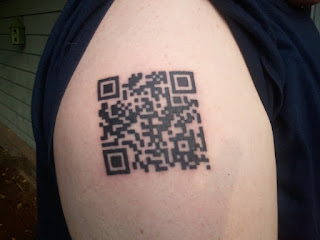This Electronic Tattoo Turns Your Skin Into A Screen

Putting clock-radio-style numbers on your skin might not seem all that desirable. But flashing digits are the proof of concept for a new electronic skin. In theory, "e-skins" like the one described Friday in Science Advances could be used for everything from monitoring vital signs to making wearable electronics a whole lot more wearable.
Lots of researchers are working on so-called smart skins. The idea is to package electronic sensors into a super-thin, super-flexible material - so thin and flexible that the user could wear it like a temporary tattoo. Recently, one research group even made a functional smart skin out of office supplies, such as Post-it notes and foil, showing that the whisper-thin electronic sensors need not be made from expensive materials.
Creating smart skins that include display screens is the ultimate goal: This would allow hospitals to monitor the vital signs of their patients with a simple stick-on patch. And in your day-to-day life, you could have the capabilities of a smartwatch in the palm of your hand - or wherever else you wanted them.
What's new about this latest skin is its longevity: Unlike most skins, which can only work for a few hours, the prototype worked for more than a day. This is because the University of Tokyo team created a protective coating to keep air and water vapor out of the skin's delicate inner workings. They also report that the polymer light-emitting diodes (PLEDs) that create the skin's displays are more efficient than those produced previously.
 |
| QR Tattoo |
For now, the skin just displays blood oxygen levels, which are detected by measuring light as it passes through the body. In this case, a light-emitting skin would be stuck to the finger to read blood oxygen levels, and the results would be displayed on the larger smart skin display.
Replacing a fingertip pulse oximeter with a couple of temporary tattoos isn't exactly earth-shattering, but it's a step in the right direction. And according to other researchers, the team's super-flexible protective layer could be used to make other devices more resilient.
"The formation of [an] ultrathin and flexible passivation layer is a challenging task," Hyun Hyun Ko of the Ulsan National Institute of Science and Technology told LiveScience. "Their fabrication process includes the solution coating and chemical vapor deposition methods, and thus can be scaled up for commercial products."
It may be a while before smart skins make it into your local hospital - or onto your body. But in a world where we're increasingly attached to our electronic devices, fusing directly to the technology seems kind of inevitable. Watching videos incognito on the inside of your hand will take some more sophisticated light emitters than are currently available at this size and flexibility, but it's not hard to reimagine the Tokyo team's blood oxygen monitor as a calendar, clock, or notification counter. One day soon, that smug co-worker of yours may be able to wear her inbox zero right on her sleeve.


Comments
Post a Comment